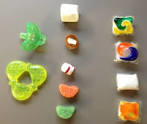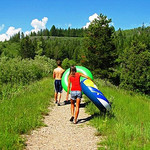
by Marie Arick | Aug 24, 2015
 Consumer Reports recently pulled their previous endorsement for laundry detergent pods in light of the potential poisoning hazard for young children. Just to be clear, this is only the laundry pods that contain the highly concentrated liquid detergent, not pods containing powdered detergent. Although these laundry pods are quickly accessed, pre-measured, use less packaging, and are just simple to use, they ultimately are not worth the lives of children. Ariana Eunjung Cha of The Washington Post recently highlighted this excerpt from Consumer Reports:
Consumer Reports recently pulled their previous endorsement for laundry detergent pods in light of the potential poisoning hazard for young children. Just to be clear, this is only the laundry pods that contain the highly concentrated liquid detergent, not pods containing powdered detergent. Although these laundry pods are quickly accessed, pre-measured, use less packaging, and are just simple to use, they ultimately are not worth the lives of children. Ariana Eunjung Cha of The Washington Post recently highlighted this excerpt from Consumer Reports:
‘When curious kids find their way into regular liquid laundry detergent, the result is often nothing worse than an upset stomach. Laundry detergent pods are presenting more serious symptoms. Along with vomiting, lethargy, and delirium, some victims have stopped breathing.’
Additionally, two children have died from ingesting a concentrated laundry detergent from a pod. Cha also noted “Last year, 11,714 reports of incidents involving kids aged 5 and younger and laundry detergent pods were reported to poison control centers nationwide. In the first six months of this year, there were more than 6,000.” This is a truly alarming fact that the numbers continue to rise. The Children’s Hospital Los Angeles posted this list on their blog:
Helpful Tips for Safety at Home
Tip 1: Cleaning materials should always be stored out of the reach of children and pets.
Tip 2: Install child-proof latches on under-sink cabinets in the kitchen and bathroom. Even if cleaning materials are no longer stored there, chemical smells may linger and could be dangerous to a child if they play under sinks.
Tip 3: Store laundry products on high shelves because many detergents can cause rashes or itching on a child’s sensitive skin.
Tip 4: Never leave a bottle or container of cleaning supplies open and unattended. Always close and put away the cleaning supplies if you are interrupted. You do not want any temptation sitting around that may harm your child.
Tip 5: When cleaning, take only the proper amount you need from the container, seal the container back up, and store the container away immediately. Use the proper equipment for handling the cleaning supply material, as recommended on the label. If the label says “Wear protective gear, gloves, or goggles,” do so to reduce harm to yourself and family.
Tip 6: When you are done cleaning, properly dispose of paper towels and rags that have come in contact with the cleaning chemicals.
Tip 7: Keep a list of emergency telephone numbers. Many cleaning products and chemicals have instructions on what to do if the product is used incorrectly, resulting in an emergency. Create and keep a first-aid kit that includes emergency-wash liquids. In the first-aid kid, keep a list of telephone numbers for:
- National Poison Control, 1-800-222-1222
- The nearest hospital
- A local ambulance service
- Your family doctor
The American Cleaning Institute urges consumers to “Pledge Now to be the KEY to a safe laundry room and routine!” Click here to take the pledge and for helpful tips for keeping your family safe.
Remember, treat all household cleaning items with care and always err on the side of caution. Look at the product you are purchasing and be aware of potential dangers. Review the warning labels and store in secured areas per label instructions. Always keep in mind: manufacturers use a product label to draw our attention to their product and this, however unintended, applies to children as well! Be diligent in keeping children safe. Personal convenience will never be more important than the life of a child.

by Judy Corbus | Jun 26, 2015

Photo Credit: Chris Luczkow, www.flickr.com
The bright, beautiful colors of a fireworks displays are a sight to behold and the highlight of July 4 celebrations across the country. But, it’s important to be careful when selecting and using fireworks for your family’s celebration. The National Council on Fireworks Safety offers these consumer safety tips:
- Check and obey local laws regarding what types of fireworks are legal in your area. Laws vary by state and municipality.
- Only buy consumer fireworks from a licensed store, tent, or stand. Never buy fireworks from an individual’s house or from someone on the street. Such devices are likely illegal explosives or professional 1.3G fireworks that can seriously injure you. Illegal explosives are often unpackaged and wrapped in brown paper. They are unlikely to have any safety warnings or the place of manufacture.
- Know your fireworks; read the cautionary labels and performance descriptions before igniting.
- A responsible adult should ALWAYS supervise fireworks activities. Never give fireworks to children.
- Do not consume alcohol while using fireworks.
- Wear safety glasses when shooting fireworks.
- Always have a bucket of water and charged water hose nearby.
- Light one firework at a time and then quickly move away.
- Use fireworks OUTDOORS in a clear area, away from buildings and vehicles.
- Never relight a “dud” firework. Wait 20 minutes and then soak it in a bucket of water.
- Never carry fireworks in your pocket or shoot them into metal or glass containers.
- Do not experiment with homemade fireworks.
- Dispose of spent fireworks by wetting them down and placing in a metal trash can away from any building or combustible materials until the next day.
- FAA regulations PROHIBIT the possession and transportation of fireworks in your checked baggage or carry-on luggage.
- Report illegal explosives, like M-80s, Quarter Sticks, and Cherry Bombs, to your local fire or police department.
Use your fireworks according to instructions and safety warnings and enjoy a safe, happy Fourth of July!
Source: National Council on Fireworks Safety, http://www.fireworksafety.com/

by Ginny Hinton | Jun 26, 2015

Photo Credit: Vicki Vargason
On June 20, 2015, a two-year-old boy in Bay County, Florida, drowned in his family’s above-ground pool after being able to get out of the house undetected. Drowning is a very real risk for young children, especially in Florida. Drowning is quick and silent. A child can drown in less than one minute in one inch of water. This year, there have been 39 drowning fatalities in Florida. Of those, 69% (24) have been children under three years of age.
In Florida, we love our beaches, pools, lakes, rivers, and creeks. How can we enjoy Florida’s beautiful water and still protect the ones we love? The answer is simple – but not necessarily easy. Injury prevention experts in Florida agree that the key to water safety is establishing layers of protection. There are three primary layers: Supervision, Barriers, and Emergency Protection.
First, establish a method of supervision and always have a responsible adult watching children who are near water. Even at a party where there are lots of adults available nearby, one should always be assigned as the “water watcher” to keep an eye on the kids.
Second, set up barriers that physically block children from entry to an unsupervised pool or body of water. Effective barriers include the following:
- Pool safety fencing with self-closing, self-latching gates
- Door, window, and pool alarms
- Childproof locks
- Professional pool cover or net (Note: Homemade pool covers may fail and actually trap children in water)
- Locking pet doors
Of course, YOU are always the most important layer of protection, but secondary barrier methods can literally save a life. The cost for setting up barriers can range from $20 to over $1,000. Experts advise that you purchase and use the most protection that you can afford.
The third layer is emergency preparedness. There is a small, precious window for resuscitating a child who is drowning – but only if someone knows what to do. It is a good idea for all adults, not just parents, to become CPR-certified in case of a water emergency. A phone should always be kept handy to call 911 in case something happens.
A 2007-2009 campaign called “Keep Your Eyes on the Kids” reduced the number of children ages one to four who drowned by 15% and the overall drowning rate by 18%. By taking a few important steps, we can do a lot to protect the little ones we love.
References: http://dcf.state.fl.us, http://drowningpreventionfoundation.com, http://nova.edu/ichp/drowning/, http://floridahealth.gov, http://waterproofFL.com, http://flsafepools.com

by Ricki McWilliams | May 18, 2015
 Beware of Hidden Dangers
Beware of Hidden Dangers
We all know that taking safety measures, such as using car seats correctly or basic childproofing, for our children is important. But what about “hidden dangers?” One major hidden danger can be the family vehicle. As summertime approaches and the heat is upon us, the dangers of leaving a child in a vehicle can be just as deadly as being involved in a traffic accident.
What’s the Danger?
While abduction may be the first concern that comes to mind when a child is left unattended in a vehicle, another concern is temperature. Outside temperatures ranging from 80 – 90 degrees can translate to temperatures of 120-140 degrees inside a vehicle (even with a window cracked). At such increased temperatures, children are at risk for heat stroke, high fever, dehydration, seizures, stroke, and even death. Even on a milder day (70 degrees), the inside of your car can reach temperatures over 100 degrees. While there may be several reasons a child is left in the vehicle unattended, the National Highway Traffic Safety Administration reports these as the top three:
- Infants and toddlers are simply forgotten in their car seat
- Toddlers or preschoolers sneak into the car to play and can’t get out
- Kids get trapped in the trunk
Heat Isn’t the Only Issue
The dangers of being left alone aren’t limited to a child overheating. Ever think about leaving the car running with the air conditioner on? Even if just for a few minutes, a child can be abducted, engage the transmission and drive off, get stuck in a power window, or press the power locks without knowing how to unlock the doors when you return. When wondering if it’s okay to leave you child in the car ~ just don’t do it.
Safety Tips to Keep Your Kids Safe:
- Don’t leave them in a car, which can quickly heat up, especially on a hot, sunny day
- Always lock your car and secure the keys so your kids can’t get to them
- Warn your kids about playing in the car by themselves without adult supervision
- Install a trunk release mechanism so they can’t get trapped in the trunk
- Get your kids out of the car first, and then worry about getting the groceries, etc., out of the car when you get home
- Make sure child care providers and day care workers have a plan to ensure kids aren’t left in the day care provider’s car or van
Deaths of children in hot cars*
- 2015: 2 (as of May 12, 2015)
- 2014: 30
- 2013: 43
- 2012: 34
- 2011: 33
- 2010: 49
Looking for a Child Passenger Safety Technician to complete a car seat check? Contact Ricki McWilliams, rickim@ufl.edu to find a technician in your area.
For more information on protecting children from other unintentional injuries click here.
Enjoy your summer and enjoy it safely!
*Source: Details are available at http://noheatstroke.org

by Ricki McWilliams | Apr 14, 2015
 Spring has Sprung
Spring has Sprung
Still trying to get past those winter blues? Get outside, enjoy the Spring weather, and do something active! Regardless of age or fitness level it is important to incorporate physical activity into your daily routine.
Some people might say they cannot be active due to lack of time however, fitting in physical activity can be simple and easy. As little as 10 minutes of activity at a time can provide healthful benefits. Being physically active can limit conditions such as heart disease, type 2 diabetes, high blood pressure, high blood cholesterol, and risk of stroke (Physical Activity, 2015). There are many types of physical activity; aerobic, muscle strengthening, bone strengthening, and balance and stretching.
To make exercise easy, fun and beneficial just mix and match:
- take a 10 minute walk at lunch time
- walk the dog
- garden
- lift weights
- join an exercise group
- practice yoga
- jump rope
- swim
Make being active a family affair. Strengthen family bonds and improve quality of life through a variety of outdoor activities that provide exercise and entertainment. Outdoor family fun activities include but are not limited to: walking, hiking, swimming, running, bicycling, kayaking, canoeing, and tree climbing. The body is able to convert sunshine into vitamins and when physically active the body releases good endorphins improving mood/outlook. Good for the mind and body, outdoor activities can also increase awareness of the environment, as well as, be easy on the budget.
Click here for more tips on how to increase physical activity at home, work and play. Make being active a part of your daily routine.
Still feeling like there are barriers keeping you from being active? Read more here on overcoming common barriers to physical activity.
Resource:
Physical Activity. (2015). http://www.choosemyplate.gov/physical-activity/why.html
by Heidi Copeland | Mar 24, 2015

On March 4, 2015 the EPA (Environmental Protection Agency) unveiled a new Safer Choice label/logo, which makes it easier to find household cleaners and other home products that are safer, more environmentally friendly—and still get the job done!
Finding cleaning and other products that are safer for you, your family, and the environment should be easy. Products with the Safer Choice label help consumers and commercial buyers identify and select products with safer chemical ingredients, without sacrificing quality or performance.
Safer Choice labels can be found on laundry products, all-purpose cleaners, car care products, dishwashing products, tub and tile products as well as floor care products. Some of these products will also carry a “Fragrance-free” notation.
The Safer Choice standard, formerly known as DfE’s – Standard for Safer Products (or the “DfE Standard”) identifies that the products and their ingredients met the Safer Choice label/logo requirement.
Safer Choice used the technical expertise of its workgroup (EPA scientists, formulators and even environmentalists to identify ingredients with the lowest hazard profile). While many of us take cleaning products for granted most are a highly scientific formula of ingredients, each with its distinct functional properties. Take dish washing liquid for example. Many of these products contain surfactants that aid in cleaning by reducing surface tension, solvents that dissolve or suspend materials, and chelating agents that reduce water hardness. Without the use of these ingredients we would probably complain about the effectiveness of the product.
A Safer Choice product contains the safest possible ingredients. Each ingredient has been screened for negative synergies (dangerous chemical combinations), potential human health effects, and environmental effects– based on the best available data. Safer Choice products will use ingredients with the lowest hazard in their functional class while still be high-performing.
Only products who have become Safer Choice partners can earn the right to display the Safer Choice product label/logo. Products using the Safer Choice label/logo have invested heavily in research, development and reformulation to ensure that their ingredients and finished product align at the green end of the health and environmental spectrum, while maintaining product performance.
Please note, the use of the Safer Choice label/logo does not constitute endorsement from the Environmental Protection Agency (EPA). It does however, recognize the company using the Safer Choice label/logo has gone through rigorous screening and uses ingredients with more positive human health and environmental characteristics than conventional products of the same type.
For more information see:
http://www2.epa.gov/saferchoice/safer-choice-standard
Heidi Copeland
Extension Agent II
Have a question? Contact the University of Florida IFAS – Leon County Extension office at 606-5203, weekdays 8 a.m. to noon or 1 to 5 p.m.
University of Florida IFAS – An Equal Opportunity Institution

 Consumer Reports recently pulled their previous endorsement for laundry detergent pods in light of the potential poisoning hazard for young children. Just to be clear, this is only the laundry pods that contain the highly concentrated liquid detergent, not pods containing powdered detergent. Although these laundry pods are quickly accessed, pre-measured, use less packaging, and are just simple to use, they ultimately are not worth the lives of children. Ariana Eunjung Cha of The Washington Post recently highlighted this excerpt from Consumer Reports:
Consumer Reports recently pulled their previous endorsement for laundry detergent pods in light of the potential poisoning hazard for young children. Just to be clear, this is only the laundry pods that contain the highly concentrated liquid detergent, not pods containing powdered detergent. Although these laundry pods are quickly accessed, pre-measured, use less packaging, and are just simple to use, they ultimately are not worth the lives of children. Ariana Eunjung Cha of The Washington Post recently highlighted this excerpt from Consumer Reports:







